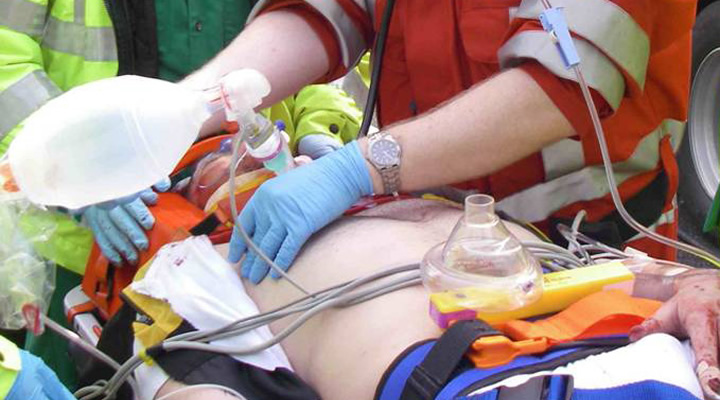Traumatic Cardiac Arrest
Cardiac arrest associated with trauma is associated with a poor outcome, particularly in blunt trauma, but if reversible causes can be treated quickly there is a chance of recovery:
- External catastrophic haemorrhage control
- Correction of hypoxia
- Decompression of tension pneumothorax
- Further bleed control and correction of hypovolaemia
Interventions should be carried out within the first 60 seconds of management. Clinical assessment can be deferred until key interventions are completed.

External Catastrophic Bleed Control
DDIT method:
- D - Direct Pressure: apply firm direct pressure at the site of bleeding using a sterile dressing and hold it in place. Elevate the limb if possible.
- D - more Direct Pressure: If bleeding continues and soaks through the dressing then apply another dressing directly over the first.
- I - Indirect Pressure: Apply pressure to the artery proximal to the bleeding point, eg femoral artery at the groin, brachial artery along the humerus.
- T - Tourniquet: Apply above the site of haemorrhage and tighten until bleeding stops. Tourniquets can be improvised using the windlass Technique but they are less effective than purpose made ones, e.g. Combat Application Tourniquet
Hypoxia
Establish an airway. Consider using a supraglottic airway if this is quicker. This can be changed to an endotracheal tube later. Ventilate with 100% oxygen.
Tension Pneumothorax
Perform bilateral finger thoracostomies regardless of clinical findings .
Hypovolaemia
Place pelvic binders and femoral traction devices as indicated. Give warmed blood or fluid boluses if blood not available . Give Tranexamic Acid and Calcium. Bilateral humeral head intraosseous access may be faster than peripheral venous access. If the patient is asystolic despite correction of hypoxia then further treatment is likely to be futile and use of limited blood supplies would not be appropriate.
Monitoring
ETCO2 monitoring should be used to guide response to treatment.
All patients must have cardiac monitoring placed to exclude an arrhythmia.
CPR
CPR and adrenaline are not helpful in hypovolaemic cardiac arrest and are likely to get in the way of the above interventions which take priority. It may be of benefit if there is a medical cause for the trauma, hypoxic cardiac arrest, blunt cardiac injury, electrolyte disturbances or acidosis. However in these situations outcome is likely to be poor.
Resuscitative thoracotomy
This may be considered in cardiac arrest from penetrating trauma with organized electrical activity on the ECG AND/OR cardiac movement on ultrasound:
- In an agonal state (dilated pupils, irregular breathing, barely palpable central pulse)
- Signs of life in the last 10-15 minutes
- Penetrating wound in chest OR abdomen/pelvis potentially involving the heart